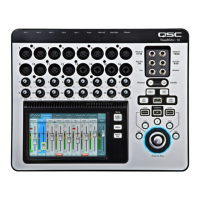32
TD-000472-00-B
Input Channel – Compressor
The Compressor controls the dynamic range of a signal above a set Threshold.
Refer to — Figure 21 –
1.
Comp Tab
– Selects the Compressor screen.
2.
In
– RMS input level
3.
Out
– Output level after any applied compression
4.
GR
– Gain Reduction – (red) indicates how much the signal is being reduced by the
compressor.
5.
Threshold Slider
– Sets the point at which the compressor will begin to reduce signal
level.
6.
Compressor Graph
– When the Compressor is engaged, the trace changes to yellow.
•
Vertical Scale
– From 0 dB to -60 dB
•
Threshold
(E)
•
Ratio
(B to E)
•
Attack time
(A to C)
•
Release time
(C to D).
7.
Attack Slider
– Adjusts how quickly the compressor reacts to a signal that exceeds the
threshold.
8.
De-Esser Knob
– Adjusts the amount of compression at the frequencies of sibilant consonants such as “s”, “z”, and “sh”.
9.
Comp In Button
– Engages and disengages the compressor.
10.
De-Esser Button
– Engages or disengages the De-Esser.
11.
Release Slider
– Adjusts how quickly the compressor stops compressing when signal falls below threshold.
12.
Knee In Button
– The knee determines whether the compressor comes on abruptly (not engaged) or gradually (engaged) as the threshold
is crossed.
13.
Gain Knob
– Adjusts the overall output gain to makeup any loss after the signal is compressed.
14.
Simple Button
– Turns Simple mode on and off. Hides all controls except:
• Comp In button
• Simple button
• Reset button
• Compression knob
15.
Reset Button
– Sets all the Comp controls to their factory default position.
16.
Ratio Slider
– Sets the ratio of input level to output level when the signal exceeds the threshold.
Home Select an
Input Bank
Touch Select
Button
Select
Comp Tab
CompIn 2
Inputs 1-8
— Figure 21 —
2
3
4
5
6
1
7
8
9 10 11
12 13 14 15 16
A
B
C D
E

